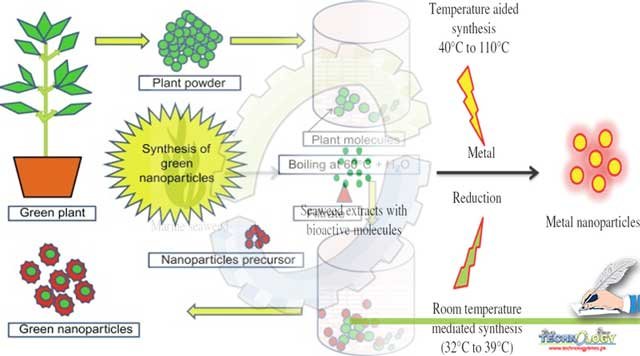“The Advancement of modern organic agriculture sector is necessary to ensure food and nutritional quality by innovative approaches like nanotechnology”

Applications of Nanotechnology in Agriculture:
Agriculture sectors serve the largest boundary between human and its surrounding environment. Agriculture loses ranges from 20-40% may be 50% worldwide. Due to the increased population around the globe, the availability of natural resources is decreasing on daily basis. Due to such circumstances agriculture sector is currently facing numerous challenges regarding food security and conservation of natural resources. So, in such conditions, Green nanotechnology serves as a handy tool for the preservation of agroecosystem.
Nanotechnology is a miracle science that is playing a crucial role in boosting agriculture production by maximizing nutrient use efficiency and minimizing losses. Nanotechnology is one of the precision farming technique which is used in improving crop production but not damages water and soil system. The term “Nano” refers to materials with dimensions of 1-100 nm. Nanotechnology covers all technologies related to the Nano-scale. Nanotechnology is used to create a wide variety of nanomaterial for different industries, including medical, agricultural, electronics, and food. Among them, agriculture need more attention due to the increasing demand for food for the people
In Agriculture sector it has numerous positive impacts proved by scientific research as follows:
- Boosting crop productivity: Nano formulations such as nanoparticles, nanocapsules and nanoemulsions are used as nano pesticides and nano fertilizer for boosting crop productivity by increasing nutrient use efficiency, plant protection against pests and diseases.
- Soil water retention: Nanoparticles such as nanoclays are used for water management by retaining water in the soil matrix so that it can be available to plants gradually.
- Water purification: Due to its unique property of nanotechnology towards recalcitrant contaminants it is being explored for the treatment of wastewater.
- Crop Biotechnology: Nanotechnology is being used for increasing disease resistance in plants by plant breeding strategies.
- Diagnostic: Nanosensors are biochemical sensors that may be used to monitor environmental situations, plant health, and growth, including nanofibers, fullerenes, electrochemically active carbon and wi-fi sensors.
In the current era, the biological synthesis of nanoparticles is evoking interest as it aims to use microbes and plants with less harmful impacts on the environment and human health. Green nanotechnology has decreased the greenhouse gasses emissions such as carbon dioxide, methane and nitrous oxide from the agricultural area.
Microorganism-mediated synthesis of nanoparticles:
Microbes have shown the potential of synthesis of nanoparticles as they are environmentally friendly as well as cheap as compared to other physical and chemical method. The mechanism behind its synthesis includes distinct ways. The metal ions are being trapped on the surface of microbes then with help of enzymes reduction of entrapped metal ions into nanoparticles takes place.
Many studies have shown that microbes including bacteria, yeast and fungi are used for biosynthesis of nanoparticles by various methods such as extracellular and intracellular but in the current era, extracellular methods have gained much attention it doesn’t include downstream processing steps such as sonication to break down the cell wall, several centrifugation and washing steps required for nanoparticle purification required in intracellular methods.
Extracellular synthesis of nanoparticles
In the Extracellular synthesis of nanoparticles, microbes are cultured by incubation in a shaking incubator for 1-2 days then the culture obtained is centrifuged to remove biomass. The supernatant obtained is then used for synthesis by adding a filter and sterilized metal salt solution into it and is incubated again. The change in color media shows the synthesis of nanoparticles which is different for various nanoparticles such as gold nanoparticles shows color changed to deep purple from ruby red. To remove any medium components or large particles after incubation mixture is centrifuged at different speeds. Finally, the nanoparticles can be centrifuged at high speed or washed thoroughly in water or solvent such as ethanol or methanol and collected in the form of a pellet at the bottom.
Intracellular synthesis of nanoparticles
In the intracellular synthesis of nanoparticles same procedure up to color change. After the incubation period, the biomass is removed by repeated cycles of ultrasonication, washing, and centrifugation. These steps help to break down the cell wall and enable the nanoparticles to be released. The mixture is then centrifuged, washed, and collected.
Plant-derived nanoparticles
Plant extracts are also used for the synthesis of nanoparticles by washing plant parts such as root, leaf, bark with demonized water then cut into pieces and for extraction is boiled then extract is purified by filtration and centrifugation. Depending on the plant species and parts different ratios of plant extract, metal salt solution, and water are used for nanoparticle synthesis. Then is incubated further to reduce the metal salt and a color change is noted and a similar protocol is followed for collection as in microorganism-mediated synthesis. Due to the presence of phytochemicals and biomolecules such as proteins, amino acids, vitamins, polysaccharides, polyphenols, terpenoids, and organic acids green nanotechnology is preferred.
Advantages of Biological Nanoparticles
Biosynthesis of nanoparticles have the following advantage compared to other physical and chemical methods:
- Are free from toxic contamination of by-products
- Eco-friendly production protocols
- Cost-effective and biocompatible nature of synthesized nanoparticles
- It does not require further stabilizing agents because plant and microorganism
- Constituents themselves act as capping and stabilizing agents
Conclusion
Incredible advancements in the biosynthesis of nanoparticles by using both microbes and plants are being illustrated over a decade but more work is still to be done to improve the efficiency of the synthesis of nanoparticles. The biological synthesis of nanoparticles is a little slow procedure so work on reduction of time for synthesis will make this approach more appealing as well as attractive on a practical basis.
This Article have been written by Ammara Saeed (Institute of Soil and Environmental Sciences, University of Agriculture Faisalabad)